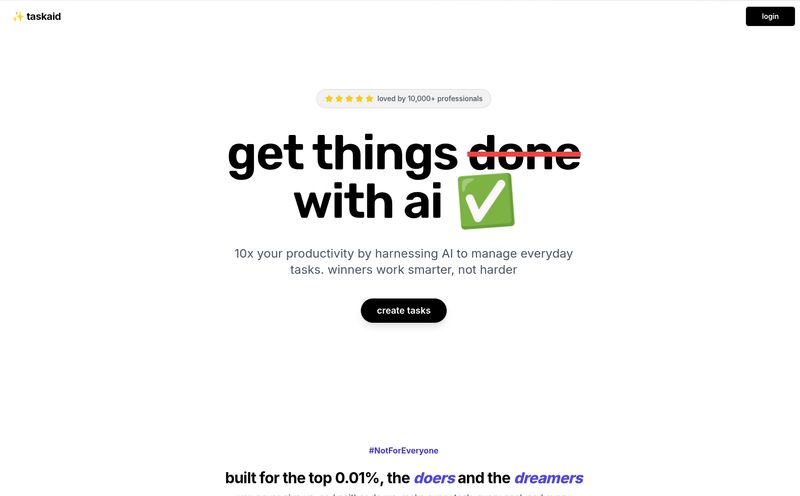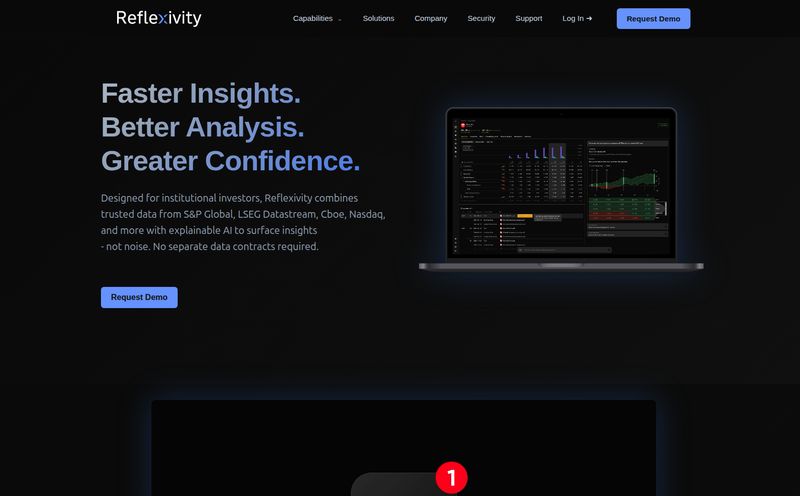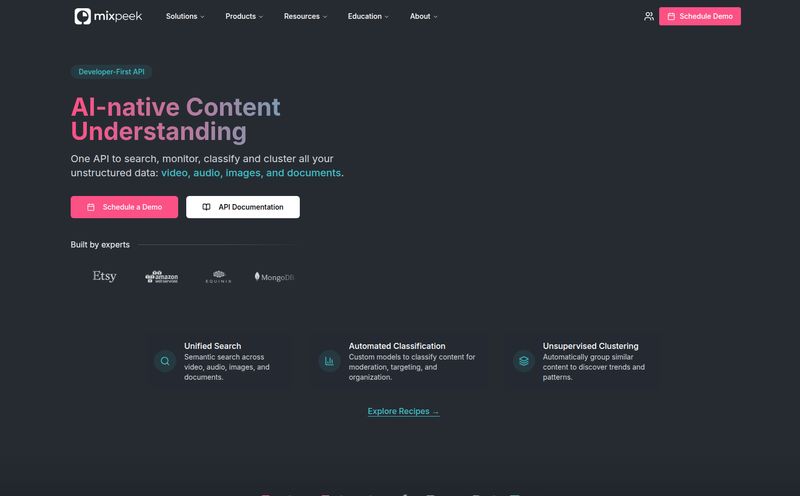We’ve all had a conversation with a chatbot that felt… well, like talking to a wall. A very polite, sometimes helpful, but ultimately soulless wall of text. For years, we in the SEO and digital marketing space have been obsessed with optimizing these little chat windows for conversions and customer support. But they've always been missing something. A spark. A face. A connection.
I’ve seen dozens of platforms try to solve this. Most end up looking like something out of a mid-2000s video game, stuck deep in the uncanny valley. So, when I stumbled upon Trulience and their promise of an “AI powered workforce,” my inner cynic raised an eyebrow. But my inner tech geek leaned in a little closer. Could this be the tool that finally gets it right?
I’ve spent some time kicking the tires, and what I found was pretty interesting. It’s not perfect, but it’s a serious contender in the race to humanize our digital world.
What Exactly is Trulience? (And Why Should You Care?)
Think of it this way: you’ve spent a ton of time and money developing or fine-tuning a Large Language Model (LLM) like GPT or something similar. It’s the brilliant brain behind your customer service operation. Trulience is the platform that gives that brain a body—or at least, a very convincing, interactive 3D face.
It’s not a chatbot builder itself. It's more like a digital marionette. You bring the puppeteer (your AI), and Trulience provides a beautifully crafted, lifelike avatar that can speak, gesture, and interact with users on your website or in your app. And we're not just talking about digital humans. You can create animals, cartoon characters... whatever fits your brand. Imagine a friendly cartoon fox guiding kids through an educational site, or a calm, professional digital human answering complex questions about financial products. The potential is huge.
The Core Features That Actually Matter
A lot of platforms throw a laundry list of features at you. I prefer to cut through the noise and look at what makes a real difference. With Trulience, a few things really stood out to me.
More Than Just a Pretty Face: AI Conversational Smarts
The biggest deal here is the “bring your own brain” approach. Trulience integrates with basically any conversational AI. This is incredibly smart. It means you aren’t locked into their proprietary system. If you have a custom-trained LLM that knows your business inside and out, you can plug it right in. This gives you a level of flexibility and power that pre-packaged solutions just can't match. It's not just about lip-syncing text; the platform also uses Natural Language Processing and even sentiment analysis to make the interactions feel more genuine. Your avatar can react not just to what a user says, but how they say it.

Visit Trulience
Speaking Your Customer's Language, Literally
Okay, this part is just plain cool. Trulience supports multiple languages, which is standard fare these days. But it also has on-the-fly language detection. So, if a user starts typing in Spanish, the avatar can switch to Spanish. Instantly. For any business with an international audience, this is a game-changer. It removes a massive point of friction and makes the experience feel incredibly personal and adaptive. It’s one of those subtle touches that separates a good tool from a great one.
Putting Your Avatar to Work: Easy Embedding
All this cool tech is useless if you need a team of developers six weeks to implement it. Thankfully, that doesn't seem to be the case here. Trulience avatars are designed to be easily embedded on websites and mobile apps. While I haven’t gone through the full process myself, the documentation suggests it's a straightforward affair, likely involving a snippet of code. This is where the rubber meets the road. Making advanced tech accessible is the key to adoption, and they seem to get that.
My Honest Take on Trulience: The Good, The Bad, and The Glitchy
No tool is perfect. After the initial excitement, you start to see the little cracks. So let's get real about what works and what doesn't.
The good stuff is obvious. The quality of the 3D avatars is top-notch. They are expressive and feel much more lifelike than many competitors I’ve seen. The flexibility of integrating any LLM is a massive plus for any serious business. I can already picture the use cases: next-gen e-commerce assistants, interactive training modules, digital concierges for hospitality websites… it gets your mind racing.
But, there are a few things to consider. First, the pricing. It's not for the faint of heart. The jump from the free plan to the first paid tier is significant, which could be a barrier for small businesses or solo entrepreneurs. And speaking of their website, when I went to check out the details on their pricing page, it seemed a bit… temperamental. A few broken layout elements and loading issues. It's a minor thing, probably just a temporary glitch, but it’s an ironic wrinkle for a company focused on seamless digital experiences. It just goes to show, even the pros have off days.
The All-Important Question of Pricing
Alright, let’s talk money. This is often the deciding factor, so I’ve broken down their plans. The structure seems aimed at serious users who are ready to move beyond the hobbyist stage.
| Plan | Price | Key Features |
|---|---|---|
| FREE | $0 / month | 30 interaction minutes/month, 1 ready-made avatar. Good for a test run. |
| STARTER | $199 / month | 1,000 minutes/month, 3 ready-made avatars, extra minutes at $0.05. |
| PRO | $399 / month | 10,000 minutes/month, up to 10 custom avatars, cheaper extra minutes. |
| ENTERPRISE | Flexible | Unlimited custom avatars, on-premise options, project collaboration. |
The free plan is really just a demo. 30 minutes will vanish in a heartbeat on any site with even a trickle of traffic. The Starter plan is for small businesses ready to commit. The Pro plan is where it gets really interesting, with the option for custom avatars. This is where you can create a truly unique brand mascot or a digital twin of a real person. The Enterprise plan is the classic “if you have to ask, you can afford it” tier for large-scale corporate needs.
Who is Trulience Actually For?
This isn’t a tool for your average WordPress blogger. I see Trulience fitting best with established businesses that already have a solid conversational AI strategy and are looking for that next layer of engagement. Think about these scenarios:
- E-commerce Brands: Imagine a virtual stylist helping you pick an outfit, or a tech expert walking you through product specs on a product page. This could seriously boost conversion rates and reduce returns.
- Corporate Training: Instead of a boring PDF, new hires could interact with a digital HR manager or a simulation of a difficult client. The engagement and retention would be off the charts.
- Healthcare & Finance: For industries where trust is everything, a calm, professional digital assistant could handle initial consultations, appointment booking, or explain complex terms, freeing up human agents for higher-level tasks.
- Education: A friendly, patient virtual tutor that can explain concepts 24/7 in multiple languages? Yes please.
It's for companies who understand that customer experience is the new battleground and are willing to invest in creating something memorable.
Frequently Asked Questions about Trulience
Do I need my own AI chatbot to use Trulience?
Yes, you do. Trulience provides the interactive avatar—the “face” and “voice.” You need to connect it to an existing conversational AI or LLM (like from OpenAI, Google, or a custom model) to provide the “brain.”
Can I create a custom avatar of myself or a mascot?
You absolutely can, but you'll need the Pro or Enterprise plan for that. The lower tiers come with a selection of ready-made avatars.
Is Trulience difficult to set up on a website?
They promote it as being easy to embed. For most modern websites, this typically means pasting a few lines of code into your site's header or body. You probably don't need to be a coding wizard, but some basic web knowledge will help.
What languages does the platform support?
It's multilingual and, more impressively, features on-the-fly language detection, allowing the avatar to switch languages mid-conversation based on user input.
Is the free plan actually useful for a business?
Honestly, not for a live environment. 30 minutes of interaction time per month is tiny. It’s best used as an extended demo to test the functionality and see if it's a good fit before you commit to a paid plan.
How does the per-minute pricing work?
Each paid plan includes a set number of interaction minutes per month (e.g., 1,000 for the Starter plan). If your users interact with the avatar for longer than that, you pay a small fee for each additional minute.
My Final Thoughts on This Digital Workforce
So, what’s the verdict? Trulience is a seriously impressive piece of technology. It’s a glimpse into a future where our interactions with AI are less robotic and more relational. It’s not a magic wand, and it requires a solid strategy (and budget) to make it work. It's for the builders, the innovators, and the brands who are ready to invest in the next frontier of user experience.
It’s powerful, it’s promising, and while there are some rough edges to smooth out, I’m genuinely excited to see how businesses use this. The era of the faceless chatbot is numbered, and tools like Trulience are holding the pen. I, for one, am watching very closely.



